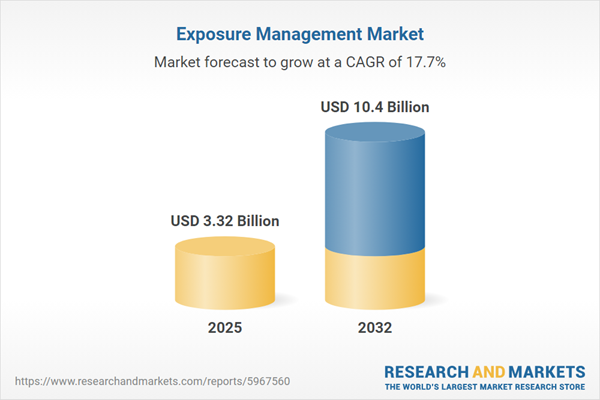Speak directly to the analyst to clarify any post sales queries you may have.
Senior executives navigating the exposure management market face a landscape shaped by multifaceted risks, stricter regulatory expectations, and accelerating digital transformation. Effective strategies must integrate governance, compliance, and actionable insights to support agile, confident decision-making.
Market Snapshot: Exposure Management Market Size and Growth Dynamics
The exposure management market demonstrates significant momentum, valued at USD 2.81 billion in 2024 and projected to reach USD 3.32 billion by 2025. Longer-term forecasts indicate sustained growth, with the market anticipated to expand to USD 10.40 billion by 2032. This growth is underpinned by intensified regulatory pressures, greater risk complexity in organizational environments, and rapid adoption of cloud-based and analytics-driven solutions. As businesses focus on real-time analytics, scalable cloud infrastructure, IoT integration, and automated vulnerability detection, their ability to maintain operational resilience and conform with both international and regional standards is strengthened.
Scope & Segmentation: Strategic Overview of the Exposure Management Market
Understanding the full scope and segmentation of the exposure management market is essential for senior leaders planning effective initiatives and optimizing resources. Advanced analytics and monitoring tools are transforming risk management, with the following market segments and technologies providing structure and specialization:
- Component Type: Managed services, professional services, and specialized applications empower organizations with risk identification, reduction of operational exposure, and process optimization, catering to diverse needs.
- Deployment Model: Private, public, hybrid cloud, and on-premise platforms deliver implementation flexibility, ensuring compliance and security priorities are met across sectors and geographies.
- Organization Size: Comprehensive frameworks are designed to scale for both SMEs and large enterprises, enabling tailored approaches to resource allocation and risk control in varying operational settings.
- Risk Type: Mapping and visualization tools enhance awareness of threats, assets, and vulnerabilities, ensuring accurate and prompt risk assessments and facilitating rapid response mechanisms.
- Vertical: Solutions customized for banking, insurance, healthcare, government, and IT/telecommunications directly address sector-specific compliance and risk management demands, adapting to complex regulation regimes.
- Regions Covered: Americas, Europe, Middle East & Africa, and Asia-Pacific markets each exhibit unique dynamics, driven by regional compliance drivers and evolving risk landscapes requiring nuanced approaches.
- Representative Companies: Industry leaders such as Qualys, Tenable, Rapid7, IBM, Microsoft, Broadcom, CrowdStrike, Palo Alto Networks, Cisco, and McAfee leverage technology innovation to propel advancements in risk mitigation and automation.
Greater adoption of analytics and continuous monitoring replaces manual procedures, enhances compliance, and improves enterprise responsiveness across global markets.
Key Takeaways for Senior Decision-Makers
- Unified exposure management practices allow early identification and assessment of organizational risks, supporting business continuity and sustainable performance.
- Automation and machine learning technologies elevate threat detection accuracy and reduce manual workloads, freeing resources for core strategic initiatives.
- Internal and external collaboration enhances collective risk awareness and leads to more rigorous governance and response strategies across the organization.
- Flexible deployment options support adaptation to both local and international compliance mandates while maintaining consistent governance and security standards.
- Industry-aligned technology ensures that risk detection and adaptation remain timely within constantly evolving operational and regulatory landscapes.
- Emphasis on continuous professional development and well-defined governance programs readies organizations for new or changing threats and regulatory updates.
Tariff Impact: Strategic Shifts in Exposure Planning
Recent US tariff policy adjustments are prompting organizations to reevaluate supply chain vulnerabilities and diversify supplier relationships. Adaptive procurement strategies combine with real-time analytics to strengthen scenario-driven risk management when encountering tariff-related exposure. Enhanced review processes, underpinned by advanced analysis tools, safeguard resilience against shifting global trade conditions.
Methodology & Data Sources
These insights are built on comprehensive executive interviews, thorough secondary research, and detailed assessment of prevailing regulatory trends. Scenario-based validation techniques confirm the credibility and practical relevance of the findings, providing trusted guidance to senior decision-makers.
Why This Report Matters
- Equips senior leaders with the actionable intelligence needed to allocate resources wisely and fortify organizational resilience in changing risk environments.
- Enables benchmarking of governance and response measures, so organizations can respond effectively as new market risks and compliance requirements emerge.
- Guides targeted planning for sectors and regions by addressing evolving exposure and compliance demands with clarity and precision.
Conclusion
By leveraging these insights, organizations can enhance their exposure management initiatives, strengthen business continuity planning approaches, and adapt more confidently to the challenges and trends shaping risk and compliance today.
Additional Product Information:
- Purchase of this report includes 1 year online access with quarterly updates.
- This report can be updated on request. Please contact our Customer Experience team using the Ask a Question widget on our website.
Table of Contents
3. Executive Summary
4. Market Overview
7. Cumulative Impact of Artificial Intelligence 2025
Companies Mentioned
The companies profiled in this Exposure Management market report include:- Qualys, Inc.
- Tenable, Inc.
- Rapid7, Inc.
- IBM Corporation
- Microsoft Corporation
- Broadcom Inc.
- CrowdStrike Holdings, Inc.
- Palo Alto Networks, Inc.
- Cisco Systems, Inc.
- McAfee Corp.
Table Information
| Report Attribute | Details |
|---|---|
| No. of Pages | 184 |
| Published | October 2025 |
| Forecast Period | 2025 - 2032 |
| Estimated Market Value ( USD | $ 3.32 Billion |
| Forecasted Market Value ( USD | $ 10.4 Billion |
| Compound Annual Growth Rate | 17.7% |
| Regions Covered | Global |
| No. of Companies Mentioned | 11 |









